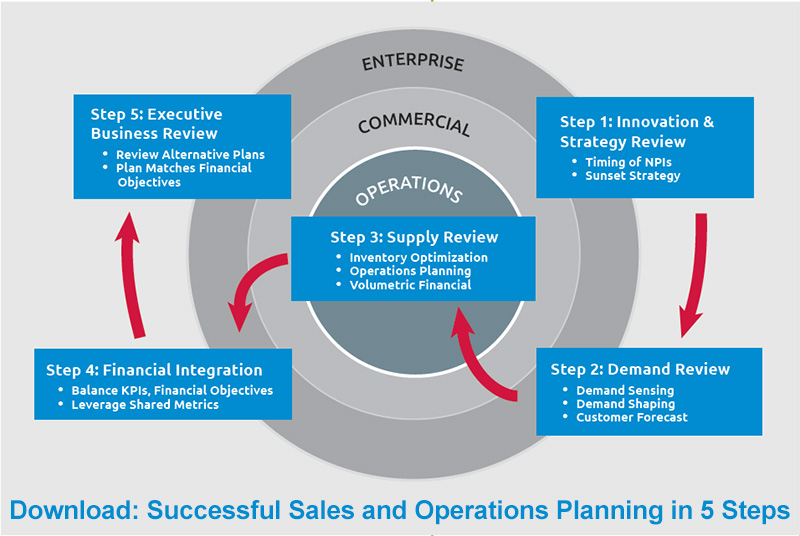Common Sales and Operations Planning Myths

This is the first of a series of five posts that investigates common myths and mistruths I have heard over the last 20+ years regarding Sales & Operations Planning (S&OP); hopefully, by exploring these myths we can generate a greater understanding of what S&OP is and what it is not.
Myth: “S&OP is Simply a Monthly Review of Historical Data.”
Many companies spend so much time correcting, manipulating, collating, and building views of historical data that they run out of time in the monthly S&OP process to accomplish much more than creating historical graphs and a simple statistical forecast.
Some S&OP efforts spend more than 60% of available cycle time just getting data ready for analysis. Much of the remaining time is spent creating monthly executive reports leaving little time for analysis.
A low-functioning S&OP process does provide executive management with a dashboard of monthly performance that is not available elsewhere due to disjointed processes and disconnected systems. With so much time spent on the past, little time is available to look into future demand projections and even less understanding available capacity to meet those projections.
S&OP processes that are supported only by rudimentary tools like spreadsheets, email and PowerPoint have limited or no ability to perform critical “what-if” scenario analysis or determine an optimal plan from a customer, financial or volumetric standpoint.
The S&OP executive meeting becomes a tedious review of detailed historical information which can result in executives finding excuses to not attend. Eventually, the S&OP executive meeting breaks down and the S&OP process stalls or fails completely.
Reality: S&OP Must Focus on the Future.
While historical data does play a role in establishing projections for a rolling 24-plus month planning horizon, the S&OP process must be able to discern whether future plans will meet financial requirements while also providing a competitive level of customer service. This process should be driven by numbers that are a result of both historic facts and informed assumptions.
Companies with more mature S&OP capabilities have a greater focus on evaluating multiple business models or “what-if” scenarios. By identifying and comparing the effects of decisions through Key Performance Indicators (KPIs), forward-thinking executives can understand the multi-dimensional aspects of more profitably managing their business.
Evaluating future scenarios enables the leadership team to identify and mitigate potential risks, assess timing and impact of new product/market introductions, and optimize plans from both a volumetric and financial standpoint. This is a highly effective use of an executive’s limited time, because executives who understand alternatives and contingencies can avoid reverting to firefighting when changes take place.
This more proactive level of planning, generally dubbed Integrated Business Planning (IBP), creates successful product/portfolio, demand, production and financial plans that meet business objectives.
IBP—being an advancement over under-powered S&OP processes—enables executives and functional managers to build optimal and synchronized plans for sales, marketing, inventory management, purchasing activities, capital expenditures and other investments along with determining optimized financial management strategies (see Aberdeen report, Integrated Business Planning: Capability Advantages for IBP Users vs. Non-Users).
IBP requires a combination of senior management commitment, process championship, team skills, process redesign, and advanced supporting technology. Support and leadership from top management is needed to make changes in organizational culture, incentive structures, and operating procedures.
Often times, senior supply chain members must open the eyes of senior management to the potential financial benefits by translating the operational improvements produced by a better S&OP process into executive level leadership language (Revenue, Profit, ROI, Stock Price, Shareholder Value, etc.).
Don’t underestimate the need to uplift and train your executive team. Manipulating data in spreadsheets to create pretty graphs is different than analyzing data, collaborating across functional groups, gaining consensus through tradeoffs, leading effective planning meetings, and understanding the business enough to propose reasonable, aligned recommendations.
An on-going training program should be developed that includes rotational assignments to ensure team members understand the big picture, and a clear career progression path to retain key personnel.
Fitting the design of the advanced S&OP (or IBP) process to the unique characteristics of the company is key. Planning involves many data inputs, collaborating functions, and process steps required to create a set of balanced and aligned plans.
As with any new endeavor, it is best to design the process utilizing a pilot approach prior to developing system requirements and selecting and implementing technology designed to support the advanced S&OP process.
Some say that S&OP is all about the team and the process and you don’t need technology to be successful. Nothing could be further from the truth. I have implemented several S&OP processes with basic tools.
It tends to go fairly well in the pilot stage, however data management and process facilitation quickly becomes overwhelming when you try to roll out to a larger part of the company.
Again, long prep time forces the team to focus only on ensuring the data is correct and displayed in the right formats. There is limited time for anything else and research shows most spreadsheets are error-prone.
Bottom-line, if you want to get more value from S&OP, you need to move up the S&OP maturity curve and move away from just focusing on short-term volumetric analysis. You will have to implement an advanced S&OP (or IBP) technology platform to streamline and accelerate the process.
More on the “No technology needed” myth is coming in a future S&OP Myth post.
Read the Full Series:
Sales and Operations Planning Myths - Part 2
In this second post in our series of S&OP myths we highlight the need for flexibility in the S&OP process to facilitate a robust and repeatable process that can support your company’s business objectives.
Sales and Operations Planning Myths - Part 3
This third in a series of posts that investigates some of the S&OP myths and mistruths and takes a look at one of the hot buttons in the industry; real-time response planning… S&OP the right solution to manage your real-time respond planning needs?
S&OP Myths Part 4 – Spreadsheets are King
The topic of today's post is one we hear often and industry research shows it is not going away fast enough, the reliance on spreadsheets and other less sophisticated solutions to manage the S&OP process.
S&OP Myths Part 5 – Lean and On-Demand Manufacturing
This is the fifth post in a series where we investigate some of the myths and mistruths around Sales & Operations Planning (S&OP).
Article Topics
Logility News & Resources
Logility makes entrance into supply chain-focused AI, with acquisition of Garvis Logility Acquires Generative AI Supply Chain Planning Firm Garvis Supply chain software platforms help to level the playing field Logility to acquire supply chain network optimization vendor Starboard Solutions Logility partners with Körber to expand capabilities How Does IKEA’s Inventory Management Supply Chain Strategy Really Work? This is Not Your Father’s Inventory Optimization More LogilityLatest in Supply Chain
Let’s Spend Five Minutes Talking About ... Malaysia Baltimore Bridge Collapse: Impact on Freight Navigating TIm Cook Says Apple Plans to Increase Investments in Vietnam Amazon Logistics’ Growth Shakes Up Shipping Industry in 2023 Spotlight Startup: Cart.com is Reimagining Logistics Walmart and Swisslog Expand Partnership with New Texas Facility Nissan Channels Tesla With Its Latest Manufacturing Process More Supply Chain


















